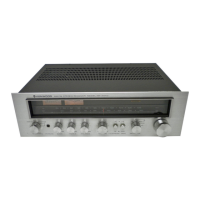
 Loading...
Loading...
Do you have a question about the Kenwood KR-4070 and is the answer not in the manual?
| signal to noise ratio at 65 dBf | 67 dB |
|---|---|
| power output (mono) | 72 dB |
| power output (stereo) | 40 watts per channel, minimum RMS at 8 ohms, from 20 Hz to 20, 000 Hz with no more than 0.1% total harmonic distortion |
| frequency response | 20 to 15, 000 Hz +0.5 dB, -2.0 dB |
| capture ratio | 1.0 dB |
| both channels driven | 40 + 40 watts 8 ohms at 1, 000 Hz |
| dynamic power output | 190 watts 4 ohms |
| total harmonic distortion | 0.1% at rated power into 8 ohms |
| intermodulation distortion | 0.1% at rated power into 8 ohms |
| power bandwidth | 10 Hz to 40, 000 Hz |
| damping factor | 40 at 8 ohms |
| stereo separation | 43 dB at 1, 000 Hz |
| power consumption | 300 watts at full power |
|---|---|
| dimensions | 360 mm |
| weight | 20.7 lb (9.4 kg) |
| usable sensitivity | 10.8 dBf (1.9 nV) |
|---|---|
| 50 dB quieting sensitivity (mono) | 15 dBf (3.1 µV) |
| 50 dB quieting sensitivity (stereo) | 37.2 dBf (40 µV) |
| usable sensitivity | 16 µV |
|---|---|
| signal to noise ratio | 50 dB |
| selectivity | 34 dB |